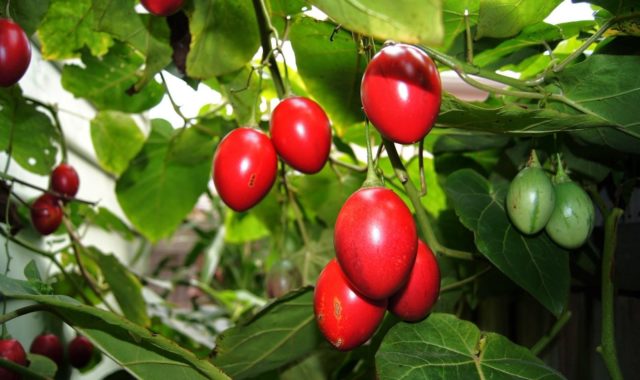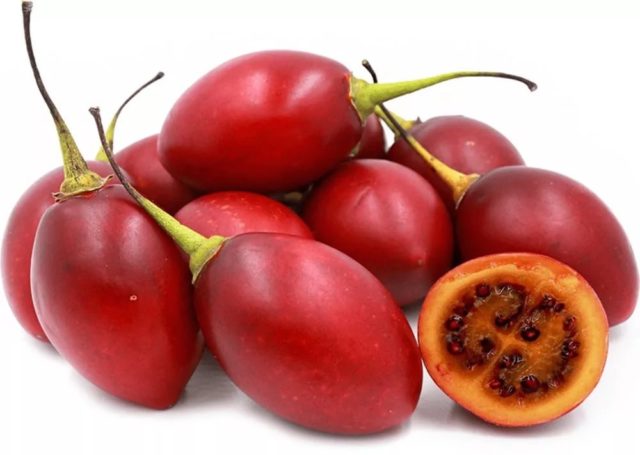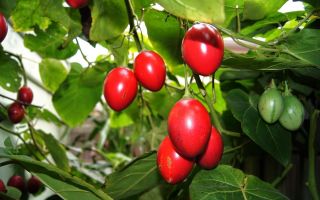Content
The beetroot tsifomandra, or tomato tree, is a fruit plant that belongs to the Solanaceae family. Tamarillo is a pseudo-Hispanic commercial name. The fruit of the tomato tree was obtained in New Zealand in 1966. The beneficial properties of the tamarillo fruit are due to the peculiarities of the chemical composition. The pulp is used to prepare various dishes.
What does tamarillo look like, where and how
Beetroot tsifomandra is an evergreen tree, bush. Tamarillo is compact in size. The plant does not exceed 3 m in height. The tomato tree is distinguished by rather large shiny oval leaves. The fragrant flowers are white with a pinkish tinge. Fruiting is noted during the second year of the beet tsifomandra's life.

The fruits of the tomato tree, or beetroot cyfomandra, grow in clusters and are egg-shaped. Their length is 10 cm. The shiny peel is characterized by hardness and bitter taste. The sweet and sour pulp is reminiscent of currants and gooseberries.
The following peel colors are available:
- yellow;
- red-orange;
- Violet.
Usually, the flesh has a golden pink hue. Thin round seeds are black in color.
The birthplace of tamarillo is unknown. Beet tsifomandra is common in the following countries:
- Chile;
- Peru;
- Bolivia;
- Ecuador;
- Argentina;
- Colombia;
- Brazil.
The tomato tree is cultivated in the territory:
- Venezuela;
- Haiti;
- Jamaica.
Tamarillo grows closer to the equator. The tree needs a tropical climate. It promotes the rapid ripening of fruits characterized by a sweet taste and special aroma.
Chemical composition and calorie content
Taste depends on the type of tomato tree:
- orange or golden, characterized by juicy pulp and large size;
- red, which is the most popular variety;
- yellow, resembling a tomato in taste.
Tamarillo has significant nutritional value. The tropical fruit is rich in:
- B vitamins;
- retinol;
- ascorbic and nicotinic acids;
- tocopherol;
- iron;
- calcium;
- potassium;
- magnesium;
- phosphorus;
- glucose.

Tsifomandra beetroot is recommended for people on a diet. This is due to the low calorie content. Energy value is 50 kcal per 100 g of product.
Useful properties of tamarillo fruit
The fruits harvested from the tomato tree are eaten. Their use has a beneficial effect on almost all body systems. Beet tsifomandra contributes to:
- maintaining the work of the nervous system;
- strengthening the immune system and bone tissue;
- normalization of stool and elimination of constipation;
- improving the functioning of the heart and blood vessels;
- reducing the risk of developing malignant tumors;
- an increase in the level of hemoglobin in the blood;
- elimination of puffiness;
- bowel cleansing;
- restoration of vision;
- preservation of youth and beauty of the skin.
The use of tropical fruits helps prevent the development of vitamin deficiencies and osteoporosis, which is especially important for women after menopause. Tamarillo contains calcium, which is considered a building material for bones. The inclusion of beet cyfomandra in the diet has a positive effect on the general condition of the skin, nails and hair. The significant content of compounds belonging to group B helps to maintain adequate functioning of the nervous system, preventing stressful conditions.
People who eat fruits harvested from the tomato tree are less susceptible to diseases of the heart and blood vessels due to their strengthening. Beetroot tsifomandra can be eaten during pregnancy. The fruit is especially beneficial for women suffering from constipation. Stool normalization occurs due to the fiber content.
Beetroot tsifomandra can be included in the children's menu. Tamarillo is rich in calcium, which is beneficial for teeth and bones. The presence of ascorbic acid is a good prevention of viral diseases.
How to eat and prepare fruit
The retention of useful properties depends on the quality of the product. When choosing tamarillo, you need to pay attention to the appearance of the fruit. In case of damage on the surface, the purchase of fruit should be abandoned. Through microcracks, harmful bacteria can penetrate into the pulp, which will cause damage to the beetroot cyfomandra.
The peel of the fruit should be of an even color. Normally, there are no dents. The peduncle in mature specimens is quite tight to the surface.
The fruit is eaten raw, peeling the skin and the top layer down to the pulp. First, the fruits are dipped in boiling water for two minutes. Then the skin is simply scraped off with a knife. The fruit can also be cut in half and eaten like a kiwi using a dessert spoon.
Tamarillo is added to various smoothies and cocktails, which allows you to give drinks a unique taste and special aroma. Popular are salads, soups, meat dishes, sauces and desserts made from the fruit of the tomato tree.
Beet tsifomandra can be preserved and frozen. The fruit should not be stored or transported for a long time.
Contraindications and possible harm
The fruit is good for your health. However, for women who are breastfeeding, the fruits of the tomato tree can be included in the diet only one year after giving birth. They are consumed in small quantities, monitoring the reaction from the child's body.
Contraindications also include age up to ten years. Otherwise, the appearance of allergic reactions accompanied by a skin rash cannot be ruled out.
Tamarillo is eaten with caution if you have a history of the following diseases:
- diabetes;
- colitis;
- gastritis.
Conclusion
The beneficial properties of tamarillo fruit explain the beneficial effects of the fruit on the body when consumed. Tsifomandra beetroot has a number of features. The product combines the characteristics of a vegetable and a fruit. In this connection, the fruits of the tomato tree are used for the manufacture of various dishes. Tamarillo is a source of important vitamins and minerals. Proper use is essential, allowing you to fully enjoy the unusual taste of the tropical fruit.

